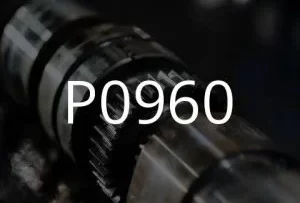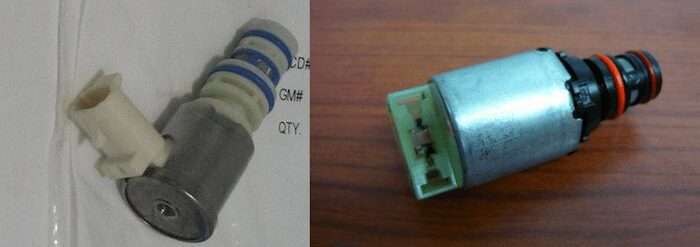
P0960 Pressure control solenoid valve “A” control circuit open
Content
P0960 – OBD-II Trouble Code Technical Description
Trouble code P0960 indicates an open circuit in the pressure control solenoid valve "A" control circuit.
What does the fault code mean P0960?
Trouble code P0960 indicates an open in the transmission pressure control solenoid valve “A” control circuit. This means that the engine control module (ECM) has received a signal that there is a problem with the transmission pressure control.
On vehicles with automatic transmissions, pressure control solenoid valves regulate hydraulic pressure. This pressure is created by a pump that is driven by the engine through the torque converter housing.
P0960 occurs when the Transmission Control Module (TCM) detects a valve failure, an open circuit, or a lack of reference voltage needed to operate the vehicle properly.

Possible reasons
Some possible reasons for the P0960 trouble code:
- Open or damaged wiring in the pressure control solenoid valve “A” control circuit.
- The solenoid valve “A” itself is faulty.
- Problems with the engine control module (ECM) or transmission control module (TCM).
- Insufficient voltage in valve control circuit “A”.
- Problems with the transmission hydraulic system, caused for example by fluid leaks or pump failure.
What are the symptoms of a fault code? P0960?
Symptoms for a P0960 trouble code may vary depending on specific conditions and vehicle configuration, some of the possible symptoms are:
- Shifting Problems: The vehicle may have difficulty shifting gears or may be delayed in shifting.
- Rough or jerky shifting: Gears may shift unevenly or jerkily, which can create an unpleasant driving experience.
- Loss of Power: The vehicle may experience a loss of power due to improper gear shifting or erratic transmission operation.
- Troubleshooting light on: The check engine light or light may come on on your dashboard, indicating problems with the transmission.
These symptoms may appear individually or in combination, depending on the specific nature and severity of the problem.
How to diagnose a fault code P0960?
The following steps are recommended to diagnose DTC P0960:
- Checking the connection and circuit of the pressure control valve: Check the connection and circuit condition of the pressure control solenoid valve. Make sure the connection is securely fastened and has no visible damage. Check electrical connections for corrosion or breaks.
- Checking the supply voltage: Using a multimeter, check the supply voltage at the pressure control solenoid valve. Normal voltage should be within the vehicle manufacturer's specifications. No or low voltage may indicate a problem with the power circuit.
- Resistance test: Check the resistance of the pressure control solenoid valve. The resistance must meet the manufacturer's specifications. Abnormal resistance may indicate a problem with the valve itself.
- Diagnostics using a car scanner: Using a vehicle scanner, read fault codes and view transmission operating parameters. Check for other error codes that may help determine the cause of the pressure control valve problem.
- Checking the transmission oil: Check the level and condition of the transmission oil. Low or contaminated oil levels can also cause problems with the pressure control valve.
- Checking mechanical components: Check the condition of mechanical transmission components, such as solenoids and valves, for damage or blockages.
After completing these steps, you can determine the cause and make the necessary repairs to resolve the P0960 trouble code. If you cannot determine the problem yourself, it is recommended that you contact a qualified auto mechanic or service center.
Diagnostic errors
When diagnosing DTC P0960, the following errors may occur:
- Misinterpretation of symptoms: Some symptoms, such as shifting problems, may be caused by other problems than just a faulty pressure control valve. Misinterpretation of symptoms may lead to incorrect diagnosis and repair.
- Insufficient checking of electrical connections: Insufficient inspection of electrical connections, including wires and connectors, may result in incorrect diagnosis. It is important to fully check the power and ground circuits and check for corrosion or breaks.
- Ignoring other error codes: Sometimes one problem can cause multiple error codes to appear. Therefore, it is important not to ignore other error codes that may be related to the operation of the transmission or the vehicle's electrical system.
- Need for specialized equipment: Accurate diagnosis and repair of some transmission components may require specialized equipment that is not always available at home. In such cases, it is better to contact a qualified specialist.
- Incorrect interpretation of scanner data: Some transmission parameters may be incorrectly interpreted when using a scanner. This may lead to incorrect diagnosis and replacement of unnecessary components.
Avoid these mistakes, follow the diagnostic process, use the right equipment.
How serious is the fault code? P0960?
Trouble code P0960 indicates an open problem with the transmission pressure control solenoid valve “A” control circuit. This is a serious problem because solenoid valves play an important role in the proper operation of the transmission by controlling gears and hydraulic pressure. If the valve is not functioning properly due to an open circuit, it can cause the transmission to malfunction, which can lead to dangerous driving conditions and vehicle damage.
Additionally, such problems can cause further damage to other transmission components and require more expensive repairs. Therefore, the P0960 code should be considered a serious problem that requires immediate attention and diagnosis.
What repair will help eliminate the code? P0960?
To resolve DTC P0960, follow these steps:
- Diagnostics and repair of open circuit: First, you need to diagnose the pressure control solenoid valve “A” control circuit. This may include checking the wiring for breaks, damage or corrosion. Once a wiring problem is identified, it must be replaced or repaired.
- Replacing the solenoid valve: If the problem is not a wiring issue, the pressure control solenoid valve “A” itself may need to be replaced.
- Checking the Transmission Control Module (TCM): Sometimes the cause may be due to a malfunction of the transmission control module itself. If necessary, it must be repaired or replaced.
- Checking other transmission components: Once the solenoid valve and control circuit problem has been resolved, other transmission components should be inspected for damage or malfunction that may have occurred due to the open circuit problem.
- Error Code Clearing and Testing: After completing the repair, you must clear the error code from the control module memory and test drive the vehicle to ensure that the problem has been successfully resolved.
It is recommended that this work be carried out using diagnostic equipment and with the help of qualified specialists.
P0960 – Brand specific information
Trouble code P0960 can occur on different makes of vehicles. Below is a list of car brands with their decodings:
- Acura: Problems with pressure control solenoid valve “A”.
- Audi: Solenoid valve “A” control circuit open.
- BMW: Pressure regulator (PC) solenoid "A" control circuit is open
- Chevrolet: Problems with pressure control solenoid valve “A”.
- Ford: Pressure control solenoid valve “A” control circuit open.
- Honda: Pressure regulator (PC) solenoid "A" control circuit is open
- Mercedes-Benz: Problems with pressure control solenoid valve “A”.
- Toyota: Pressure regulator (PC) solenoid "A" control circuit is open
Please remember that the specific meanings and interpretation of the codes may vary depending on the model and year of the vehicle. For accurate diagnosis and repair, it is recommended that you contact an authorized service center or a qualified automotive mechanic.
